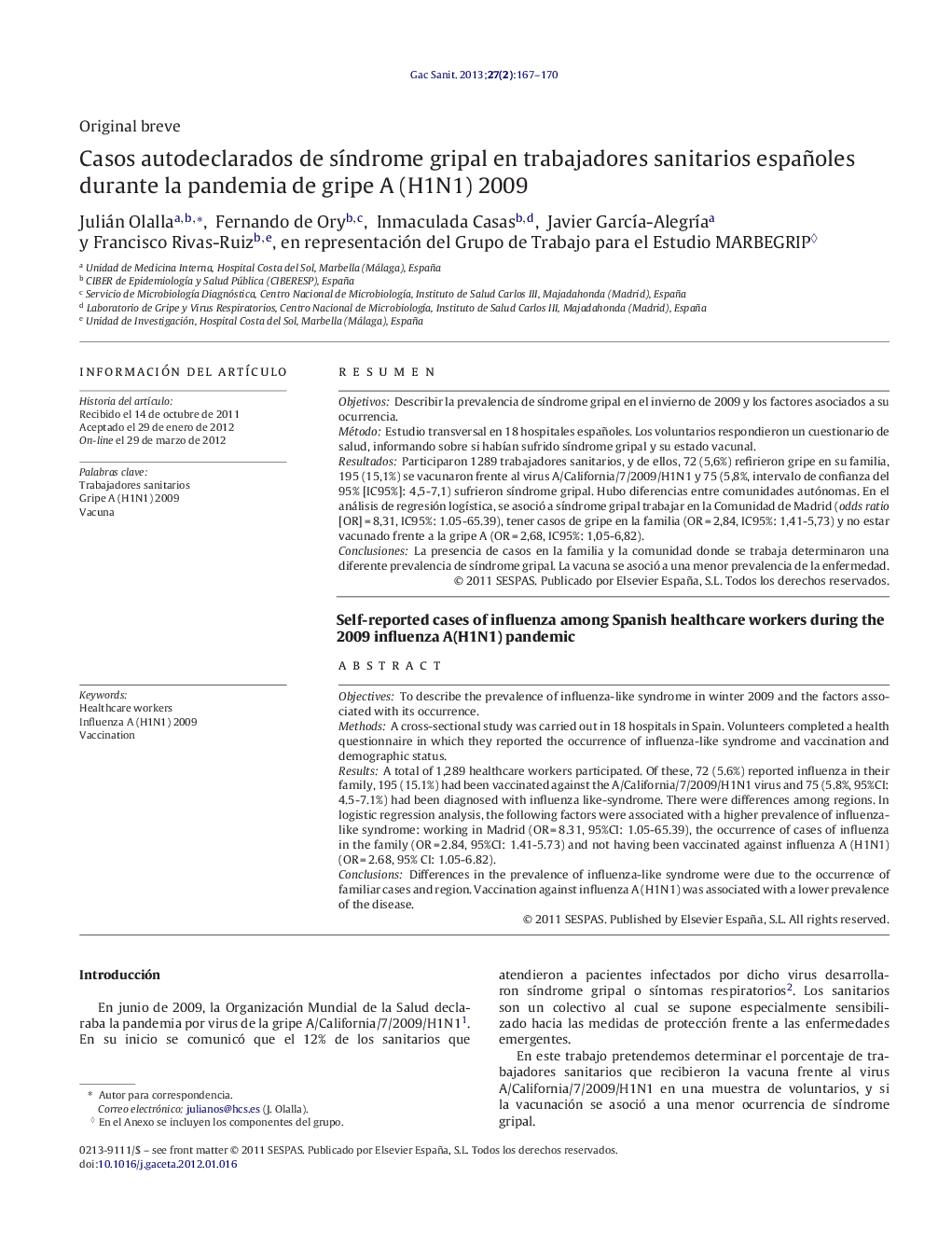| کد مقاله | کد نشریه | سال انتشار | مقاله انگلیسی | نسخه تمام متن |
|---|---|---|---|---|
| 1073435 | 949786 | 2013 | 4 صفحه PDF | دانلود رایگان |

ResumenObjetivosDescribir la prevalencia de síndrome gripal en el invierno de 2009 y los factores asociados a su ocurrencia.MétodoEstudio transversal en 18 hospitales españoles. Los voluntarios respondieron un cuestionario de salud, informando sobre si habían sufrido síndrome gripal y su estado vacunal.ResultadosParticiparon 1289 trabajadores sanitarios, y de ellos, 72 (5,6%) refirieron gripe en su familia, 195 (15,1%) se vacunaron frente al virus A/California/7/2009/H1N1 y 75 (5,8%, intervalo de confianza del 95% [IC95%]: 4,5-7,1) sufrieron síndrome gripal. Hubo diferencias entre comunidades autónomas. En el análisis de regresión logística, se asoció a síndrome gripal trabajar en la Comunidad de Madrid (odds ratio [OR] = 8,31, IC95%: 1.05-65.39), tener casos de gripe en la familia (OR = 2,84, IC95%: 1,41-5,73) y no estar vacunado frente a la gripe A (OR = 2,68, IC95%: 1,05-6,82).ConclusionesLa presencia de casos en la familia y la comunidad donde se trabaja determinaron una diferente prevalencia de síndrome gripal. La vacuna se asoció a una menor prevalencia de la enfermedad.
ObjectivesTo describe the prevalence of influenza-like syndrome in winter 2009 and the factors associated with its occurrence.MethodsA cross-sectional study was carried out in 18 hospitals in Spain. Volunteers completed a health questionnaire in which they reported the occurrence of influenza-like syndrome and vaccination and demographic status.ResultsA total of 1,289 healthcare workers participated. Of these, 72 (5.6%) reported influenza in their family, 195 (15.1%) had been vaccinated against the A/California/7/2009/H1N1 virus and 75 (5.8%, 95%CI: 4.5-7.1%) had been diagnosed with influenza like-syndrome. There were differences among regions. In logistic regression analysis, the following factors were associated with a higher prevalence of influenza-like syndrome: working in Madrid (OR = 8.31, 95%CI: 1.05-65.39), the occurrence of cases of influenza in the family (OR = 2.84, 95%CI: 1.41-5.73) and not having been vaccinated against influenza A (H1N1) (OR = 2.68, 95% CI: 1.05-6.82).ConclusionsDifferences in the prevalence of influenza-like syndrome were due to the occurrence of familiar cases and region. Vaccination against influenza A (H1N1) was associated with a lower prevalence of the disease.
Journal: Gaceta Sanitaria - Volume 27, Issue 2, March–April 2013, Pages 167–170